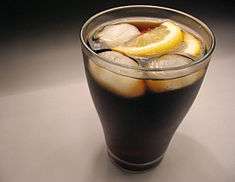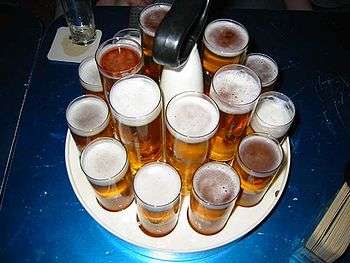List of beverages

.jpg)
This is a categorically-organized list of beverages. Beverages are liquids specifically prepared for human consumption. In addition to basic needs, beverages form part of the culture of human society. Despite the fact that most beverages, including juice, soft drinks, and carbonated drinks, have some form of water in them; water itself is often not classified as a beverage, and the word beverage has been recurrently defined as not referring to water.
Note: due to the high number of beverages in existence, this article is limited to being organized categorically, based upon the main subcategories within the Beverages category page, along with information about primary topics and list article links.
Alcoholic
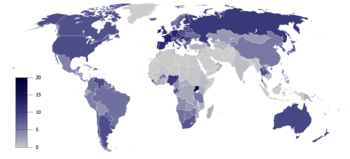
Alcoholic beverages – An alcoholic beverage is a drink containing ethanol, commonly known as alcohol, although in chemistry the definition of an alcohol includes many other compounds. Alcoholic beverages, such as wine, beer, and liquor have been part of human culture and development for 8,000 years. Many brands of alcoholic beverages are produced worldwide.
Beer
Beer – beer is produced by the saccharification of starch and fermentation of the resulting sugar. The starch and saccharification enzymes are often derived from malted cereal grains, most commonly malted barley and malted wheat.[2] Most beer is also flavoured with hops, which add bitterness and act as a natural preservative, though other flavourings such as herbs or fruit may occasionally be included. The preparation of beer is called brewing.
By country
- Beer and breweries by region
- Beer classification in Sweden and Finland
- List of beer organisations
- List of countries by beer consumption per capita
- Beer in Azerbaijan
- Beer in Belarus
- Beer in Bosnia and Herzegovina
- Beer in Brazil
- Beer in Bulgaria
- Beer in Cape Verde
- Beer in Chile
- Beer in China
- Beer in Colombia
- Beer in Croatia
- Beer in Denmark
- Beer in England
- Beer in Finland
- Beer in France
- Beer in Germany
- Beer in Greece
- Beer in Hong Kong
- Beer in Hungary
- Beer in Iceland
- Beer in India
- Beer in Iran
- Beer in Ireland
- Beer in Israel
- Beer in Italy
- Beer in Japan
- Beer in Kazakhstan
- Beer in Kenya
- Beer in Mexico
- Beer in Morocco
- Beer in New Zealand
- Beer in Norway
- Beer in Poland
- Beer in Portugal
- Beer in Romania
- Beer in Russia
- Beer in Scotland
- Beer in Serbia
- Beer in Singapore
- Beer in Slovakia
- Beer in Slovenia
- Beer in South Africa
- Beer in South Korea
- Beer in Sweden
- Beer in Syria
- Beer in Taiwan
- Beer in Thailand
Cider
Cider – cider is a fermented alcoholic beverage made from apple juice. Cider alcohol content varies from 1.2% ABV to 8.5% or more in traditional English ciders. In some regions, cider may be called "apple wine".[3]
Distilled (liquor)

Distilled beverages – also known as liquor and spirits, a distilled beverage is an alcoholic beverage produced by distillation of a mixture produced from alcoholic fermentation, such as wine. This process purifies it and removes diluting components like water, for the purpose of increasing its proportion of alcohol content (commonly known as alcohol by volume, ABV).[4] As distilled beverages contain more alcohol they are considered "harder" - in North America, the term hard liquor is used to distinguish distilled beverages from undistilled ones, which are implicitly weaker.
- List of gin brands
- List of liqueurs
- List of rum producers
- List of tequilas
- List of vodkas
- List of whisky brands
Cocktails
Cocktails – a cocktail refers to any kind of alcoholic mixed drink that contains two or more ingredients. As generally understood today, a cocktail requires at least one alcoholic component—typically a distilled spirit, although beer and wine are permissible—and one sweet component; it may also contain a souring or bittering ingredient.[5]
- List of cocktails
- List of cocktails with wine, sparkling wine, or port
- Beer cocktail
- Cocktails with cachaça
- Highball
- List of duo and trio cocktails
- List of flaming beverages
- List of martini variations
- Well drink
- Wine cocktail
Hard soda
Hard soda is a type of alcoholic beverage that is manufactured in the style of a soft drink.
Wine
Wine – wine is an alcoholic beverage made from fermented grapes or other fruits. The natural chemical balance of grapes lets them ferment without the addition of sugars, acids, enzymes, water, or other nutrients.[6] Yeast consumes the sugars in the grapes and converts them into alcohol and carbon dioxide. Different varieties of grapes and strains of yeasts produce different styles of wine. The well-known variations result from the very complex interactions between the biochemical development of the fruit, reactions involved in fermentation, terroir and subsequent appellation, along with human intervention in the overall process.
- Glossary of wine terms
- List of wine cocktails
- List of wine-producing regions
- Outline of wine
- Wine tasting descriptors
By country
- List of Appellation d'Origine Contrôlée wines (France)
- List of Italian DOC wines
- List of Italian DOCG wines
- List of Italian IGT wines
- List of VDQS wines (France)
- List of wine-producing countries
- Wine in China
Alcoholic and non-alcoholic
Barley
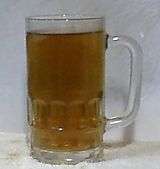
Barley-based beverages – Barley is a member of the grass family, is a major cereal grain. It was one of the first cultivated grains and is now grown widely. Barley is used in various beverages and as a source of fermentable material for beer and certain distilled beverages. In a 2007 ranking of cereal crops in the world, barley was fourth both in terms of quantity produced (136 million tons) and in area of cultivation (566,000 square kilometres or 219,000 square miles).[7]
Hot beverages
Mixed drinks
Mixed drinks – a mixed drink is a beverage in which two or more ingredients are mixed. Some mixed drinks contain liquor while others are non-alcoholic.
Non-alcoholic
Non-alcoholic beverages – Non-alcoholic beverages often signify drinks that would normally contain alcohol, such as beer and wine but are made with less than .5 percent alcohol by volume. The category includes drinks that have undergone an alcohol removal process such as non-alcoholic beers and de-alcoholized wines.
Caffeinated
Caffeinated beverages – a caffeinated drink or caffeinated beverage is a drink which contains caffeine, a stimulant which is legal and popular in most developed countries.
Chocolate
Chocolate beverages – chocolate is a processed, typically sweetened food produced from the seed of the tropical Theobroma cacao tree. Its earliest documented use is by the Olmecs of south central Mexico around 1100 BC. The majority of Mesoamerican people made chocolate beverages, including the Mayans and Aztecs,[8] who made it into a beverage known as xocolātl [ʃoˈkolaːt͡ɬ], a Nahuatl word meaning "bitter water".
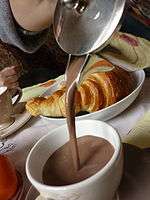 Hot chocolate served with a croissant
Hot chocolate served with a croissant
Historic
Historical beverages
Plant-based
Maize
Maize beverages
Rice
Rice drinks
Soft drinks
Soft drinks – a soft drink is a beverage that typically contains water (often, but not always, carbonated water), usually a sweetener and usually a flavoring agent. The sweetener may be sugar, high-fructose corn syrup, fruit juice, sugar substitutes (in the case of diet drinks) or some combination of these. Soft drinks may also contain caffeine, colorings, preservatives and other ingredients.
By country
By temperature
- Cold beverages
- Hot beverages
By country
- List of Bolivian drinks
- List of Brazilian drinks
- List of Korean beverages
- List of U.S. state beverages
Alcoholic beverages
By continent
Alcoholic beverages
- Beer
- Beer in Asia
- Beer in Africa
- Beer in Australia
- Beer in Central America
- Beer in Europe
- Beer in Greenland
- Beer in the Middle East
- Beer in North America
- Beer in Oceania
- Beer in South America
Brands and companies
- Brand name beverage products
- Beverage companies
Beverage brands and companies exist worldwide. The beverage industry refers to the industry that produces drinks. Beverage production can vary greatly depending on the type of beverage being produced. Innovations in the beverage industry, catalyzed by requests for non-alcoholic beverages, include: beverage plants, beverage processing, and beverage packing.[9] Ready to drink packaged beverages are those sold in a prepared form, ready for consumption.
See also
| |
|
|
| Food | Drink | Beer |
| |
|
|
| Wine | Liquor | Coffee |
| |
|
|
| Bacon | Agriculture and agronomy | Hunger relief |
- Drinking water
- Lists of beverages
- List of breakfast beverages
- List of drinking games
- List of energy drinks
- List of fictional beverages
- List of food and beverage museums
- List of foods
- List of lemon dishes and beverages
- List of lemonade topics
- List of microorganisms used in food and beverage preparation
- Water
-
 Lists portal
Lists portal
References
- ↑ "Global Status Report on Alcohol 2004" (PDF). 2004. Retrieved 2013-04-02.
- ↑ Barth, Roger. The Chemistry of Beer: The Science in the Suds, Wiley 2013: ISBN 978-1-118-67497-0.
- ↑ Martin Dworkin, Stanley Falkow (2006). The Prokaryotes: Proteobacteria: alpha and beta subclasses. Springer. p. 169. Retrieved 29 July 2011.
- ↑ Britannica Online Encyclopedia: distilled spirit/distilled liquor
- ↑ OED cocktail, n.
- ↑ Johnson, H. (1989). Vintage: The Story of Wine. Simon & Schuster. pp. 11–6. ISBN 0-671-79182-6.
- ↑ "FAOSTAT". Food and Agriculture Organization of the United Nations. Archived from the original on July 3, 2008. Retrieved 2009-05-18.
- ↑ Justin Kerr. "Chocolate: A Mesoamerican Luxury 1200—1521 – Obtaining Cacao". Field Museum. Retrieved 23 November 2011.
- ↑ "Beverage Production". Manufacturingdrinks.com. 2010-06-07. Retrieved 2013-05-21.
External links
| Wikimedia Commons has media related to beverages. |
| Look up beverage in Wiktionary, the free dictionary. |
-
 Media related to Alcoholic beverages at Wikimedia Commons
Media related to Alcoholic beverages at Wikimedia Commons -
 Media related to Beer at Wikimedia Commons
Media related to Beer at Wikimedia Commons -
 Media related to Cider at Wikimedia Commons
Media related to Cider at Wikimedia Commons -
 Media related to Cocktails at Wikimedia Commons
Media related to Cocktails at Wikimedia Commons -
 Media related to Distilled beverages at Wikimedia Commons
Media related to Distilled beverages at Wikimedia Commons -
 Media related to Maize beverages at Wikimedia Commons
Media related to Maize beverages at Wikimedia Commons -
 Media related to Soft drinks at Wikimedia Commons
Media related to Soft drinks at Wikimedia Commons -
 Media related to Wine at Wikimedia Commons
Media related to Wine at Wikimedia Commons







